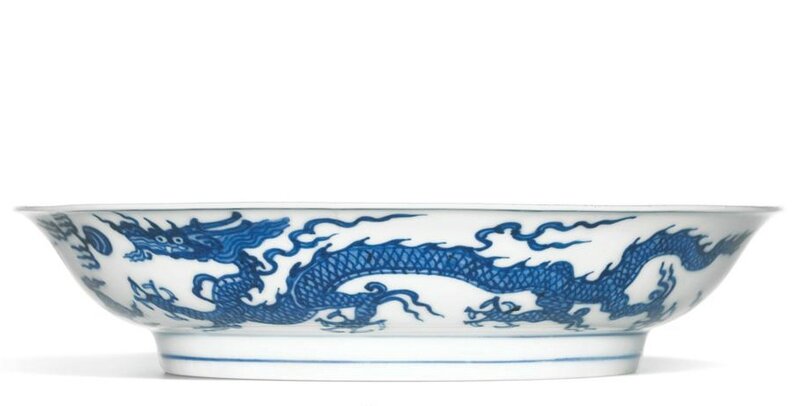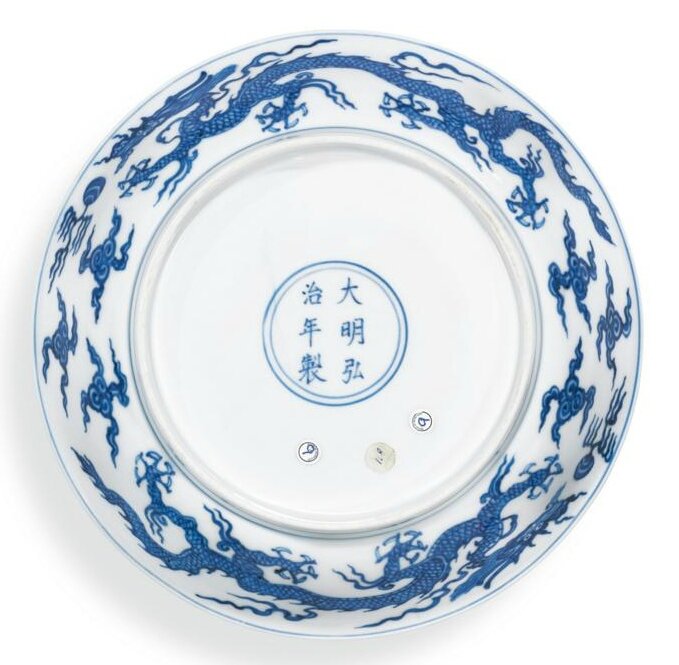A very rare blue and white ‘dragon’ dish, Mark and period of Hongzhi (1488-1505)
Lot 28. A very rare blue and white ‘dragon’ dish, Mark and period of Hongzhi (1488-1505). Estimate 500,000 — 700,000 HKD (58,472 - 81,860 EUR). Photo Sotheby's.
with shallow rounded sides rising from a tapered foot to a flared rim, the interior deftly painted in vivid tones of cobalt blue with a central medallion enclosing a five-clawed dragon writhing amongst scrolling clouds, its sinuous scaly body with flame-like projections and muscular legs terminating in powerful sharp claws, the rim bordered by a classic-scroll band, similarly decorated to the exterior with five-clawed dragons striding amongst scrolling clouds in pursuit of flaming pearls, all within line borders, the base with a six-character reign mark within a double circle - 20.1 cm, 7 7/8 in.
Provenance: Sotheby's London, 3rd December 1963, lot 103 (£550).
Bluett & Sons Ltd, London, 1963 (£550).
Collection of Roger Pilkington (1928-69), from 1963 (£550).
Bibliography: Adrian Joseph, Ming Porcelains: Their Origins and Development, London, 1971, pl. 66.
Note: This dish is striking for its glossy glaze and vividly drawn five-clawed dragons, whose complex web of scales are rendered in great detail and a sense of vitality is achieved through the careful shading. In style and composition this dish follows the tradition established during the reign of the Hongzhi Emperor’s father, the Chenghua Emperor (r. 1465-87).
Hongzhi mark and period (1488-1505) dishes of this design are rare, although a very similar example in the National Palace Museum, Taipei, is illustrated in Minji meihin zuroku [Illustrated catalogue of Ming dynasty porcelain in the National Palace Museum], Tokyo, 1977, vol. 2, pl. 67; one in the British Museum, London is published in Jessica Harrison-Hall, Ming Ceramics in the British Museum, London, 2001, pl. 7:13, together with another, potted with straight sides, from the collection of Harry Oppenheim, pl. 7:14; and a third dish, from the collection of George Eumorfopoulos, was sold in our London rooms, 29th May 1940, lot 212. See also a fragment of a dish of this type, excavated at Zhushan, Jingdezhen, illustrated in Jingdezhen chutu Mingdai yuyao ciqi [Porcelains from the Ming imperial kilns excavated in Jingdezhen], Beijing, 2009, pl. 103.
For the prototype of this design, see a dish with a Chenghua mark and of the period, in the National Palace Museum, Taipei, included in the Museum’s exhibition Catalogue of the Special Exhibition of Ch’eng-hua Porcelain Ware, Taipei, 2003, cat. no. 13.
Sotheby's. The Pilkington Collection of Chinese Art, Hong Kong, 06 avr. 2016, 10:00 AM

/https%3A%2F%2Fprofilepics.canalblog.com%2Fprofilepics%2F1%2F0%2F100183.jpg)
/https%3A%2F%2Fstorage.canalblog.com%2F03%2F02%2F119589%2F96711876_o.jpg)
/https%3A%2F%2Fstorage.canalblog.com%2F11%2F31%2F119589%2F94773502_o.jpg)
/https%3A%2F%2Fstorage.canalblog.com%2F20%2F83%2F119589%2F94772815_o.jpg)
/https%3A%2F%2Fstorage.canalblog.com%2F26%2F72%2F119589%2F75604929_o.jpg)
/https%3A%2F%2Fstorage.canalblog.com%2F59%2F60%2F119589%2F26458628_o.jpg)





/image%2F1371349%2F20240416%2Fob_2a8420_437713933-1652609748842371-16764302136.jpg)
/image%2F1371349%2F20240414%2Fob_83ee65_2024-nyr-22642-0954-000-a-blue-and-whi.jpg)
/image%2F1371349%2F20240414%2Fob_15808c_2024-nyr-22642-0953-000-a-blue-and-whi.jpg)
/image%2F1371349%2F20240414%2Fob_e54295_2024-nyr-22642-0952-000-a-rare-blue-an.jpg)